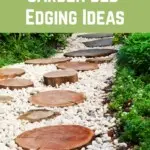
Creative garden bed edging can really make a big difference to the look and feel of your garden.
Choosing the right methods and materials is important. In this article, we will look at ideas to separate garden beds and growing areas from other garden zones.
We will focus on eco-friendly ideas that will help you create a healthy and sustainable garden.
Choosing Garden Bed Edging
There are a number of different things to consider when choosing bed edging for your garden.
The answers to the following questions will help you determine which of the creative garden bed edging ideas outlined below are right for you.
- Are the garden beds ground-level or raised beds?
- What surfaces adjoin the garden bed?
- What is growing in the garden bed/ growing area? (And how much access is required?)
- Do you want stark, hard edging, or a softer feel?
- What overall garden style are you going for?
Living Plant Bed Edging Ideas
If you are looking at a ground-level bed, and like a softer feel, living plants might be a great option for framing the area.
Certain plants can work extremely well to create soft edging between different garden zones. Here are some living plant bed edging ideas that you might like to consider:
1. Mediterranean Herb Bed Edging
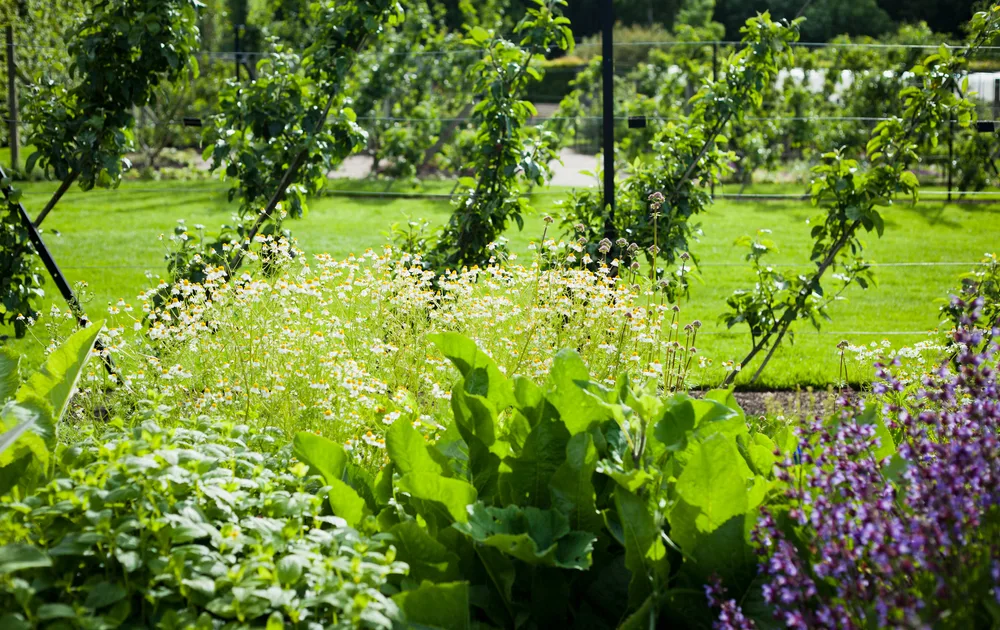
When the growing area contains edible plants, Mediterranean herb bed edging can fulfil a range of functions.
Herbs such as rosemary, lavender, thyme, oregano and marjoram can all work well in sunny and free-draining areas.
They can be useful in their ability to attract beneficial wildlife.
Their fragrant smells also mean that herb edging works well when garden beds adjoin a path or seating area. You can enjoy their fragrance as you sit near, or brush by.
2. Strawberry Bed Edging
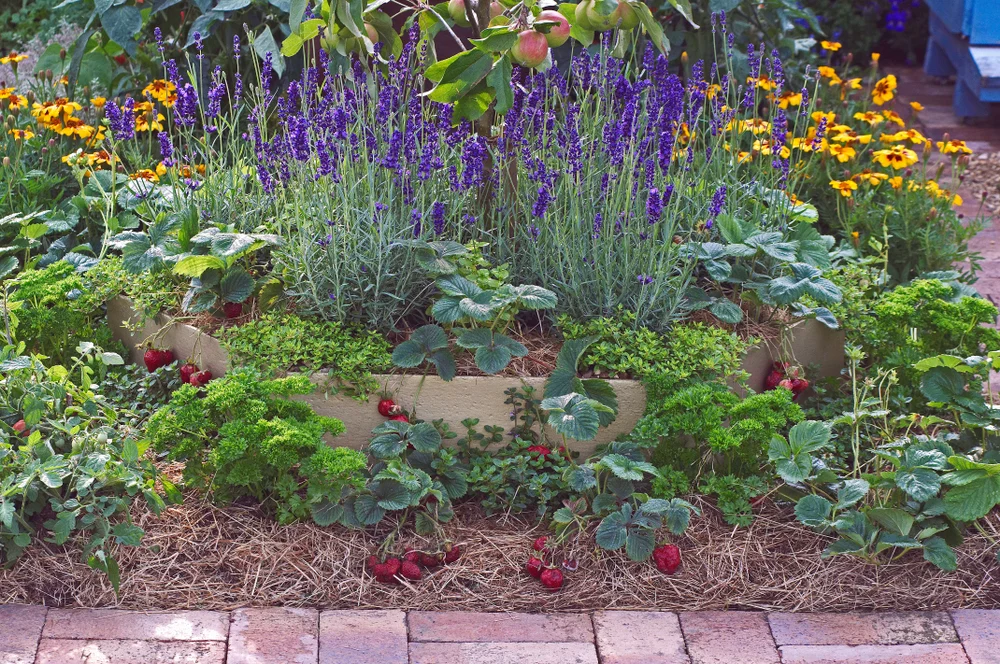
Strawberries can also work well to softly define the edges of a growing area.
Using strawberries for ground cover and as an additional edible yield can be a great idea around garden beds containing, for example, a fruit tree and its guild.
These can be a great idea where a growing area meets paving, patio, decking, or a path.
On the sunny edges of a garden bed, strawberries will often also have the chance to ripen well. Their good ground coverage will also reduce the weeding required around the edges of the space.
Of course, strawberries are just one of a wide range of edible and ornamental ground cover plants you could consider for the purpose.
A Unique Way to Use Strawberry Plants in the Landscape @ naturehills.com
3. Low Hedge Bed Edging
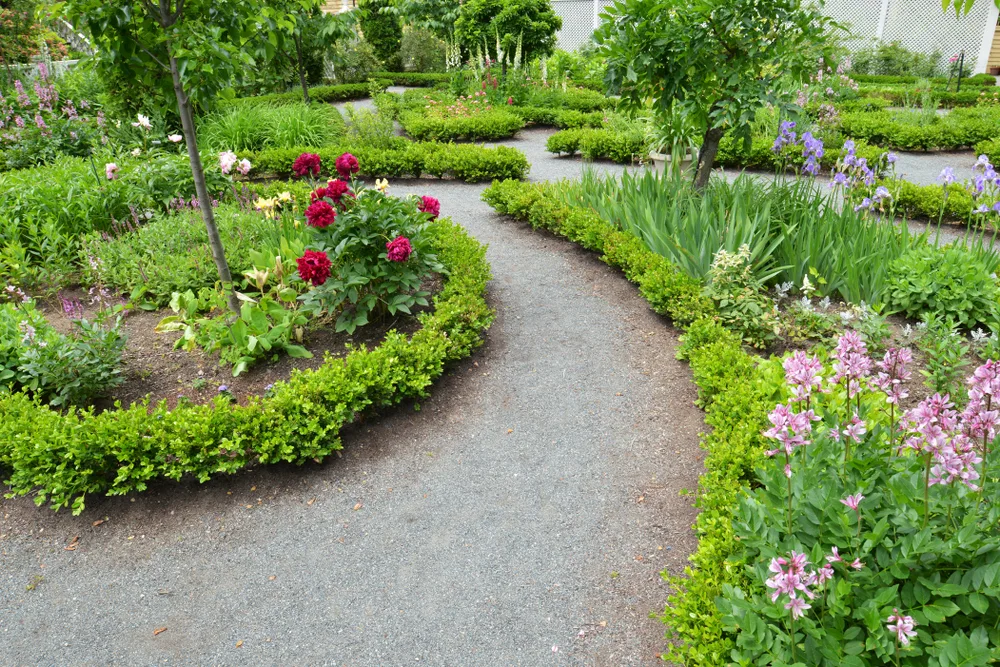
A low, clipped hedge can work well to define the edges of an annual vegetable plot or other garden bed.
Box is one plant traditionally used for the purpose.
But there are also a range of other slow-growing evergreen shrubs you could consider.
A low hedge will not suppress weeds well. And it will require regular upkeep to keep it looking neat.
But formal hedging can look impressive and works well when contrasted with less formal planting in the garden bed beyond.
Garden Hedges for Edges @ rattandirect.co.uk
4. Step-Over Fruit Tree Bed Edging
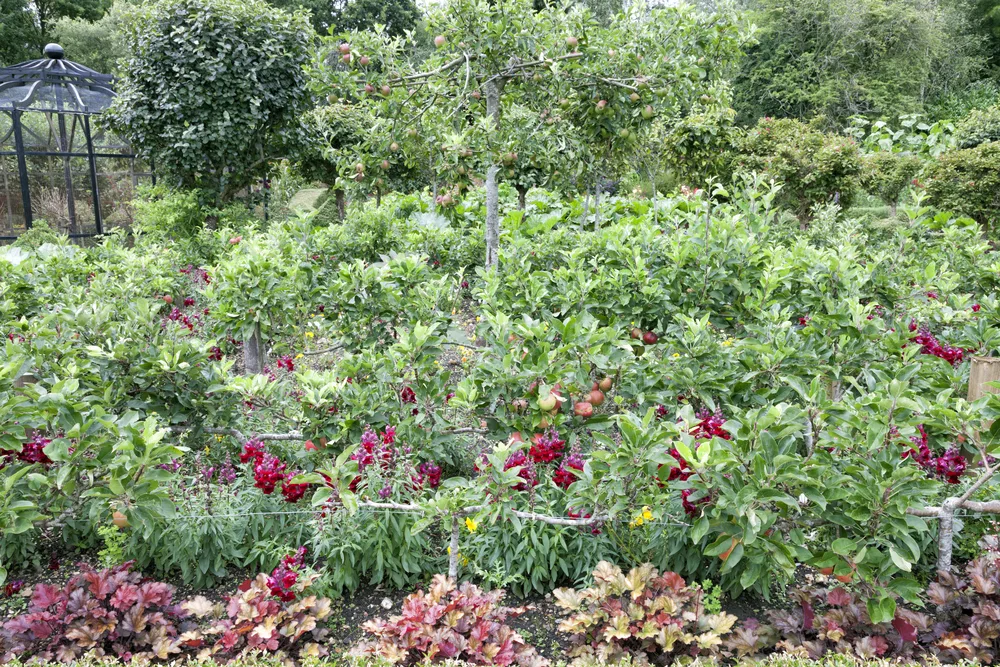
Another cool way to create some separation between a food production garden bed and other zones is to create a low barrier of step-over fruit trees.
Step over apple trees, for example, can be suited to a range of gardens.
They will not stop weeds from growing, but can be a good way to maximise yield in small spaces.
Step-Over Apples @ theguardian.com
5. Bulb Bed Edging
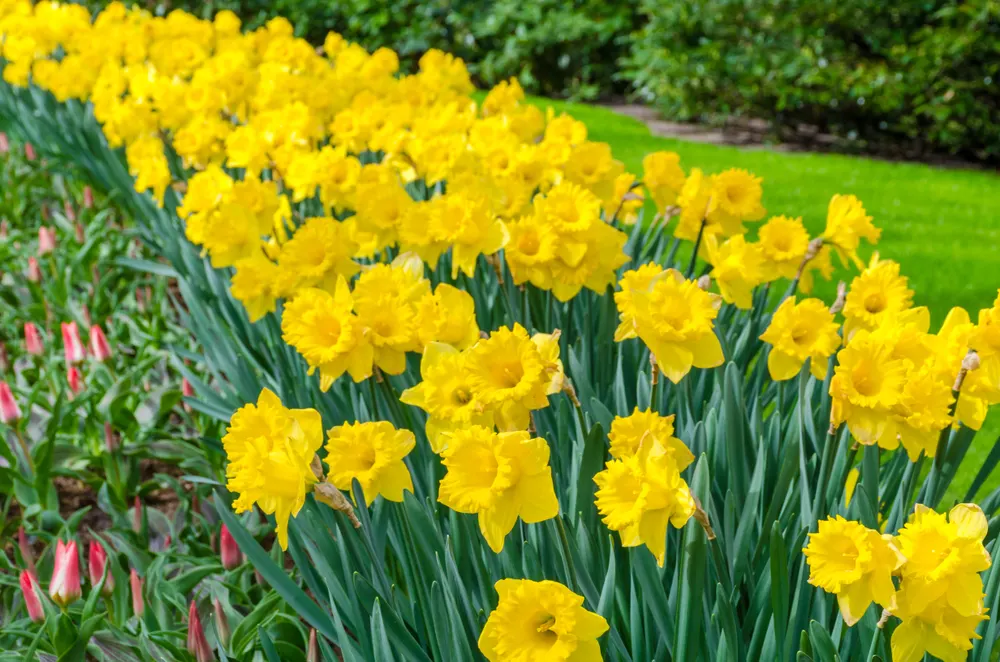
If your ground level growing area is adjoining grass, and you want a soft edge, the main challenge will lie in preventing the grass from spreading onto the garden bed.
Bulbs can be used to suppress grass growth in certain situations – for example, around the drip-line of a tree, where the growing area for a fruit tree guild meets an existing lawn.
You might choose spring flowering bulbs, like daffodils, snowdrops, bluebells and crocuses, for example.
You could also consider perennial members of the onion family.
A Simple but Stunning Border idea for Your Spring Garden @ gardenia.net
6. Mossy Rock Bed Edging
In a forest garden type design, living moss might be the dominant feature for shady garden bed edging.
You might choose to create a moss-clad edge between a deep, damp shade garden beneath a mature tree and the surrounding area, for example.
Moss may grow naturally in a shady spot in your area, but there are a range of techniques you can use to encourage more moss to grow.
How to Grow Moss @ thespruce.com
7. Meadow Flower Strip Garden Edging
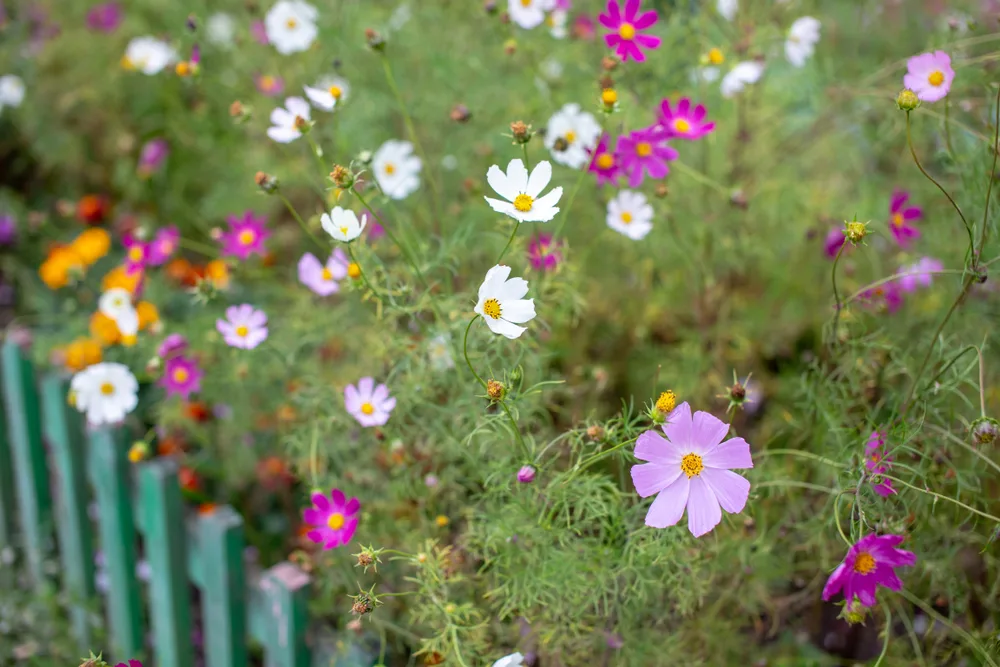
Where an ornamental bed or area of shrubby perennial planting meets a lawn, there are a range of different ways to create new garden bed edging.
If you like the idea of a softer edge, without hard surfaces or straight lines, you could consider creating a relaxed strip of meadow flowers to separate the zones.
This will work in a sunny and open spot. It is important to introduce local species to suppress grass growth.
Choose appropriate meadow flower species that will thrive in the soil and climate conditions where you live.
How to Create a Wildflower Meadow in the Garden @ daviddomoney.com
8. Succulent Bed Edging
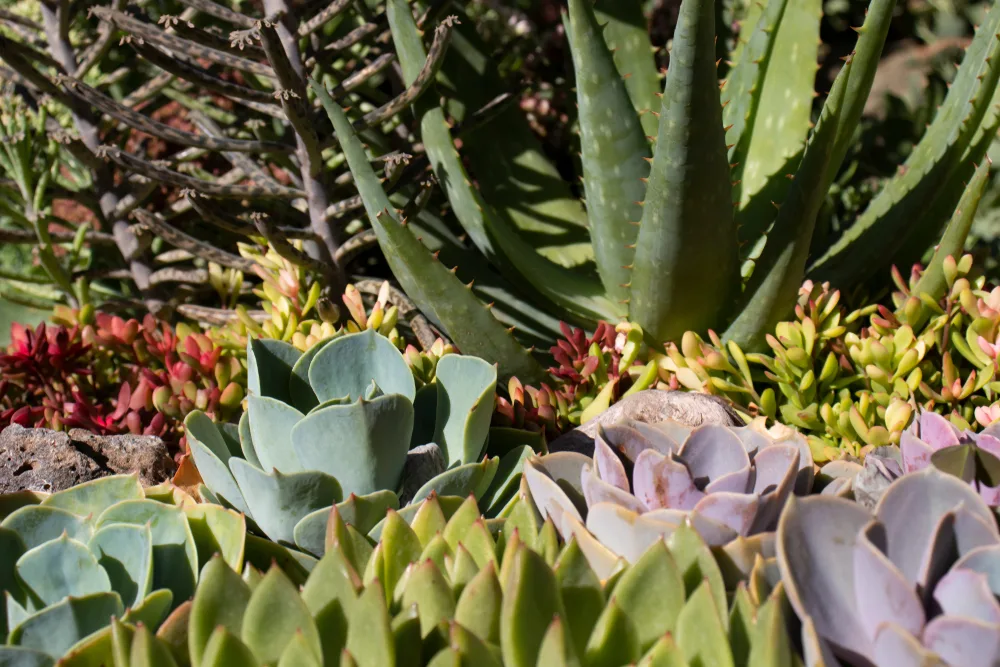
In sunny, warm areas in drier climate gardens, succulent plants could be placed to define the edges of a garden bed.
Succulents can work well in formal edging strips between a garden bed and a path or area of paving, for example.
They can also simply offer ground cover around the edges of a drought-tolerant planting scheme.
A Succulent Garden Outside @ gardeningknowhow.com
Other Natural Bed Edging Ideas
Even if living plants are not suitable for your needs, you can still choose a range of other eco-friendly and natural garden bed edging solutions.
Here are some edging ideas using natural materials that you might like to consider:
9. Wood Hurdle Bed Edging
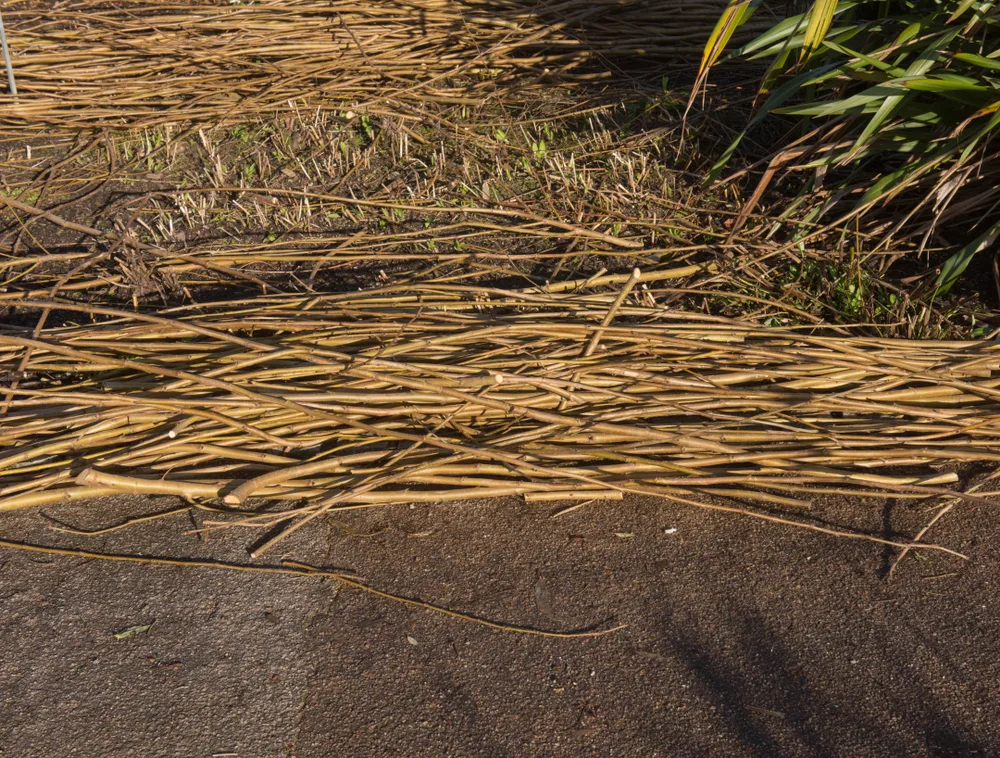
A simple, low fence or wood hurdle can look great around the edges of a garden bed.
One of the great things about this idea is that you can make one yourself.
You may even be able to use branches from your own property. To make such a fence, stakes are placed upright around the edge of the bed at regular intervals, then sturdy yet flexible branches are woven between them.
Hurdles @ lowimpact.org
10. Woven Wicker Bed Edging
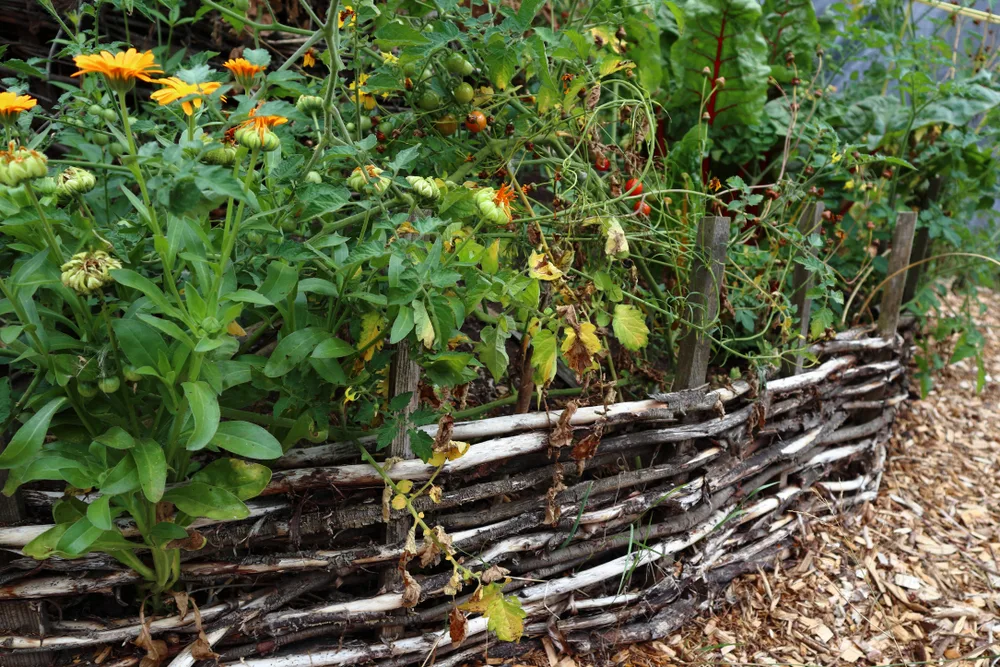
You can also use a similar technique to weave willow whips or similar into a more delicate woven fence, or wicker fence, using basketry techniques.
Intriguingly, you can also consider using living willow to create a ‘fedge’ – a cross between a natural hedge and a fence.
A low fedge could also be a great way to edge garden beds and separate garden zones.
Fedge Planting Instructions @ doublewillow.com
11. Horizontal Log Garden Bed Edging
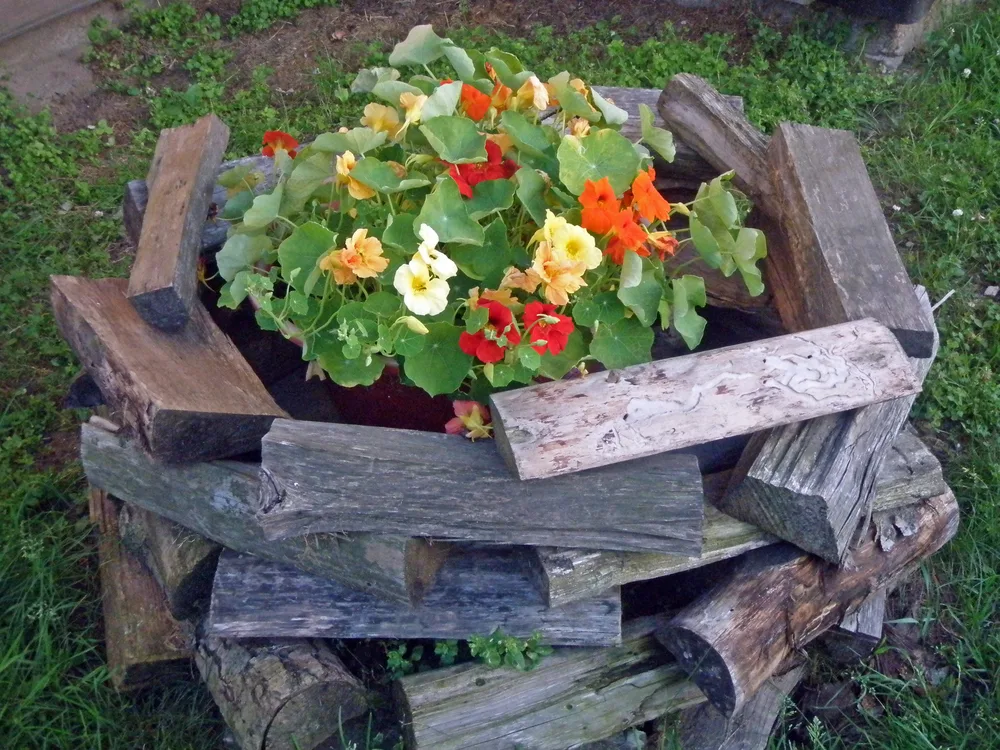
One of the easiest ways to create a separation between a ground level bed and a path, patio or other garden zone is simply to lay natural logs horizontally around the edges of the site.
Of course, you could also stack horizontal logs to create raised bed edging to a suitable height.
Log Edging @ ourhabitatgarden.org
12. Vertical Log Garden Edging
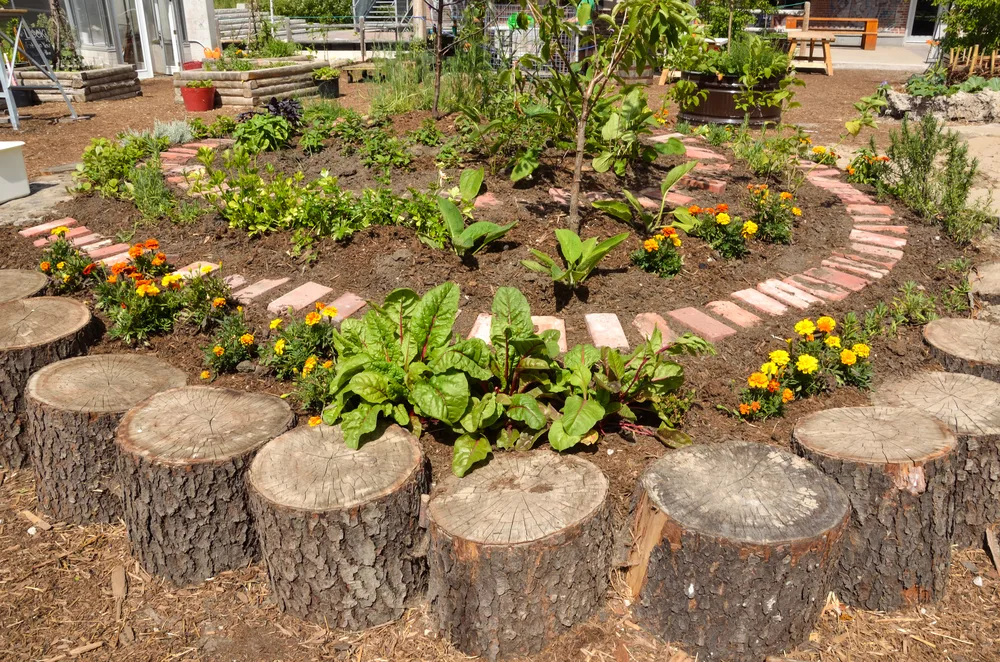
Logs can also be cut to a certain height – high or low, and placed vertically in the ground to form garden bed edging.
The logs can all be cut to the same height, or cut to different heights, or on angles, to create different effects.
The bark can be left on, or removed, depending on what overall garden style you are going for.
Wooden Garden Edging @ theartinlife.com
13. Cordwood Edging
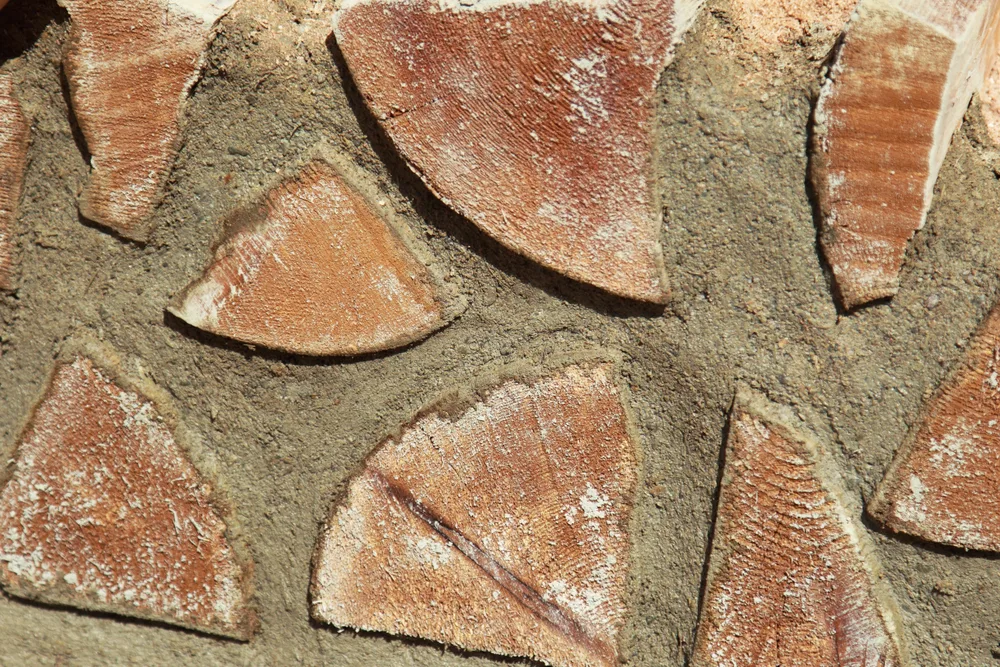
A third way to use logs in garden bed edging is to cut them into short lengths to create beautiful cordwood edging.
Cordwood could be placed to create a low-level boundary between ground level beds and paths or paving/decking.
Log sections could also be inset in the ground to create a boundary strip or path. You could also stack cordwood higher to form edging for a raised growing area.
14. Bamboo Garden Bed Edging
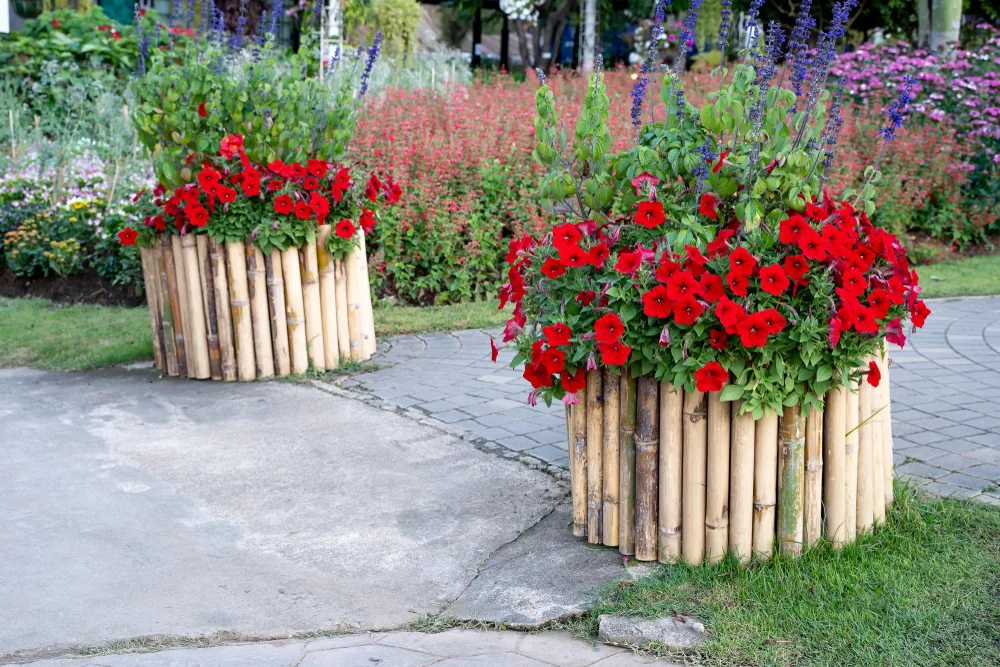
Bamboo is another incredibly useful natural material. Like wood, this plant material can be used in a huge range of different ways.
For example, wider bamboo cane sections can be placed horizontally or vertically, like the logs described above, for simple garden bed edging.
Thinner bamboo canes can also be woven into low fences or tied together in criss-cross pattern to form a simple low trellis design.
Bamboo edging @ bamboo-inspiration.com
15. Driftwood Garden Bed Edging
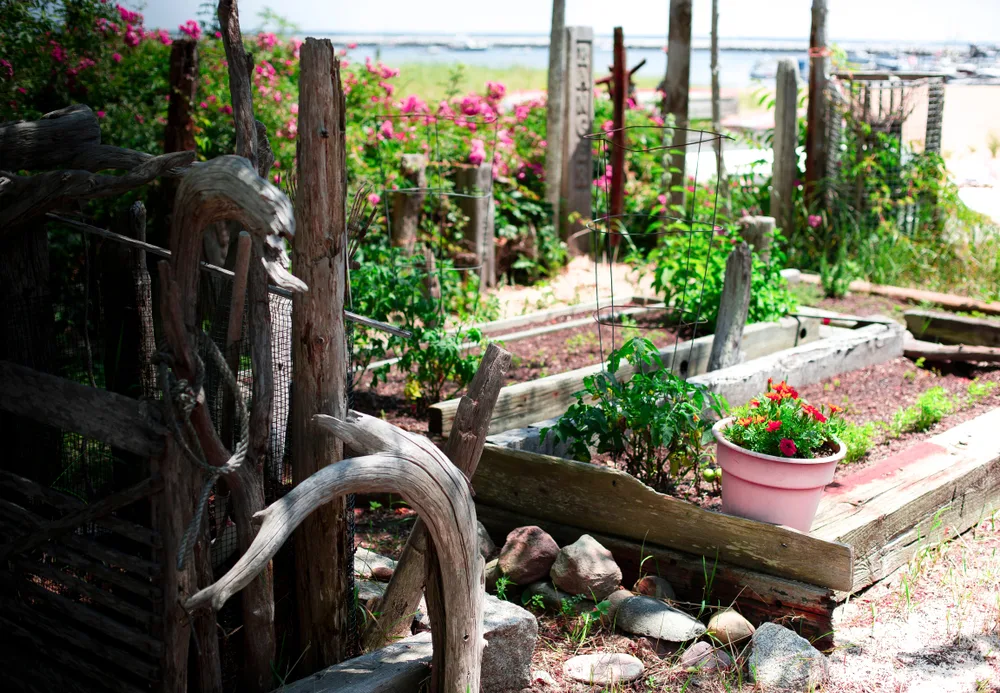
A more unusual way to incorporate natural wood into your garden is by using driftwood from a local shore to form a low fence-type garden bed edge.
It can also be laid simply around the garden boundary.
Driftwood often boasts organic shapes and a bleached colour can be beautiful in a range of different garden designs.
Whimsical Rustic Garden @ Tanyasgarden.blogspot.com
16. Shell & Sand Edging
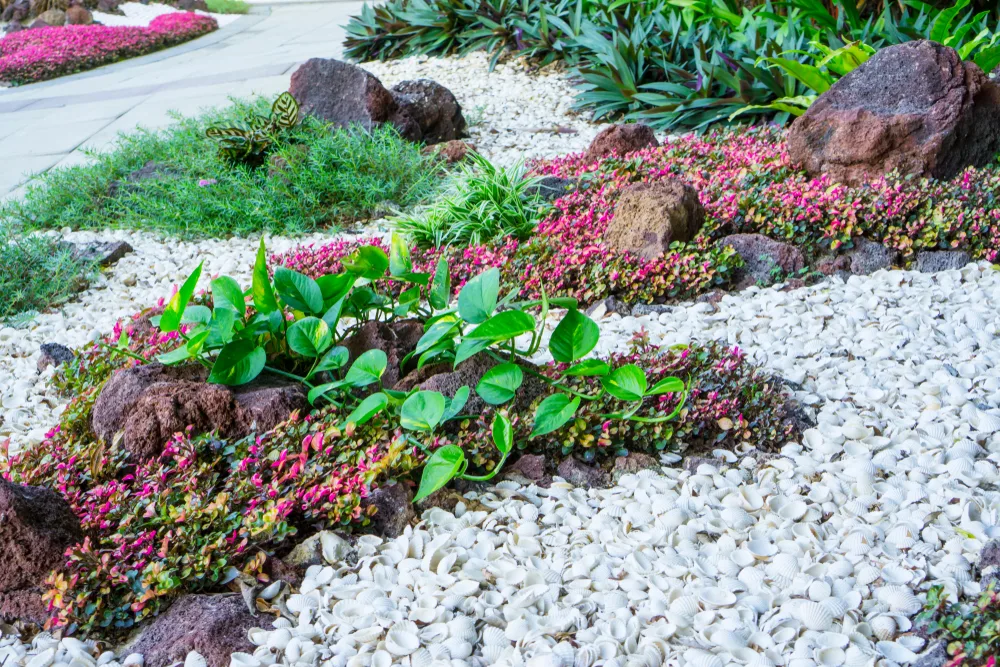
If you like the idea of driftwood, and want to create a beachy or seaside feel in your garden, you might also like to consider incorporating in-ground edging.
Between garden beds and lawn or other zones, you could create a shallow trench filled with sand and/or shells.
Shell Edging @ iloveshelling.com
17. Sea Glass Edging
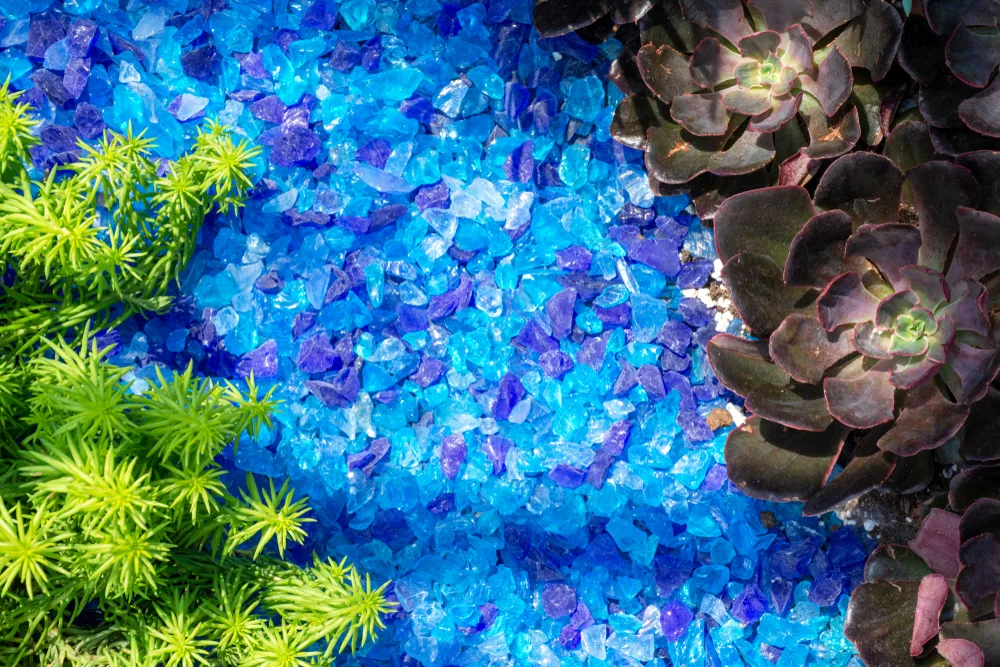
While I hesitate to include sea glass in a list of natural materials, it certainly has been shaped by nature.
Glass found on a local beach might also be a good material for decorative edging effects.
It could be added to the in-ground edging mentioned above, or be used to fill shallow trench edging on its own.
The beautiful greens, whites and blues can be truly beautiful and fit in not only with a seaside themed garden but also with gardens in a range of other styles.
Inexpensive way to build a border @ homeguides.sfgate.com
18. Natural Rope Bed Edging
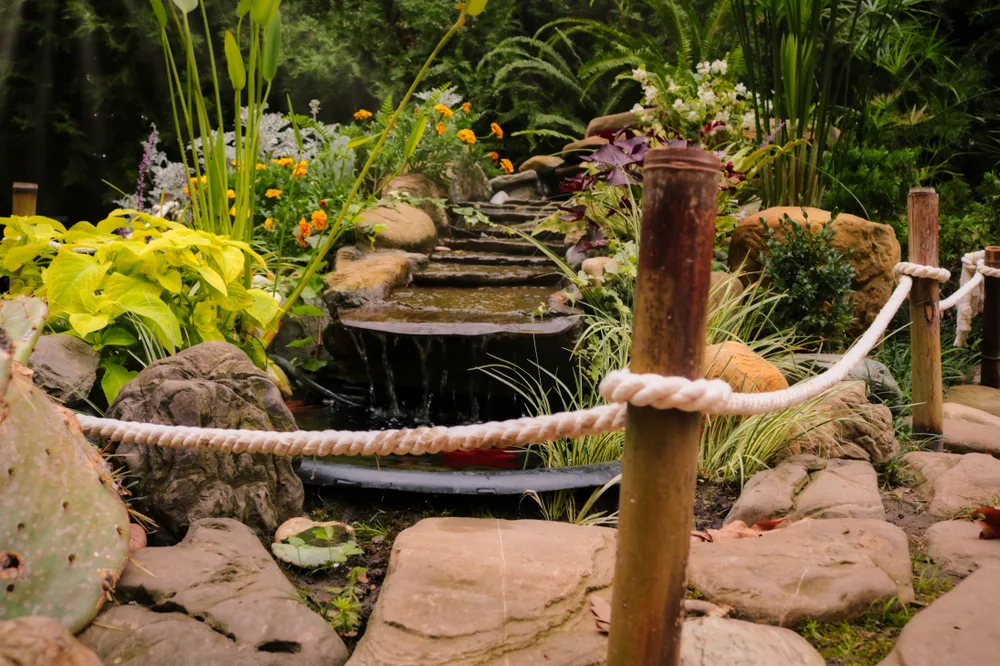
One final edging type that could add a marine or nautical edge to a garden is natural rope.
A simple hemp rope strung low between posts could help to define the edges of a growing area.
For a quirky and interesting touch, you could also consider adding found objects. Large shells, buoys etc. could be placed to hang from the rope.
Check out Diy Coastal Rope garden border @ h2obungalow.com. (But for a more eco-friendly option, choose a natural rope for the project.)
19. Natural Rock Bed Edging
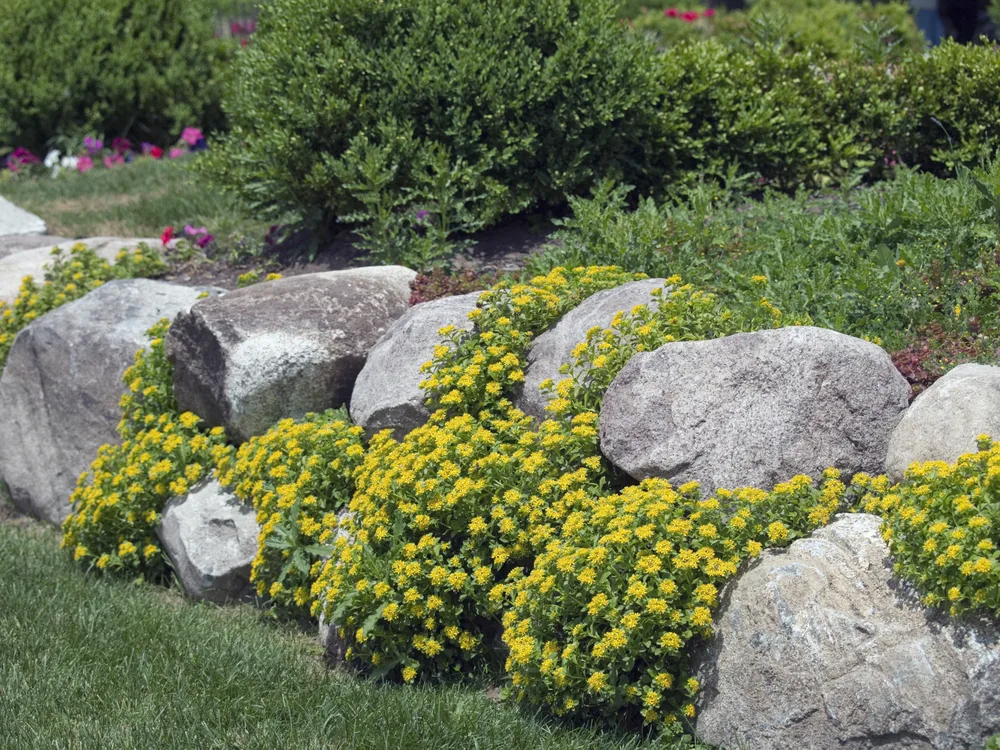
Of all the many garden edging ideas, using natural rock is perhaps the most popular. This is a versatile and enduring option.
There are a range of ways to use natural rocks and large stones to edge your garden beds. You could simply place a series of larger rocks around the edges of the growing area.
You could also stack up stones for a dry stone wall effect.
By placing river rocks or similar in the ground along the edges of a bed, you could create a cobble-stone edging effect.
These are just a few of the eco-friendly natural rock edging ideas you could consider.
Rustic garden edging @ insteading.com
20. Stone, Pebble or Gravel Edging
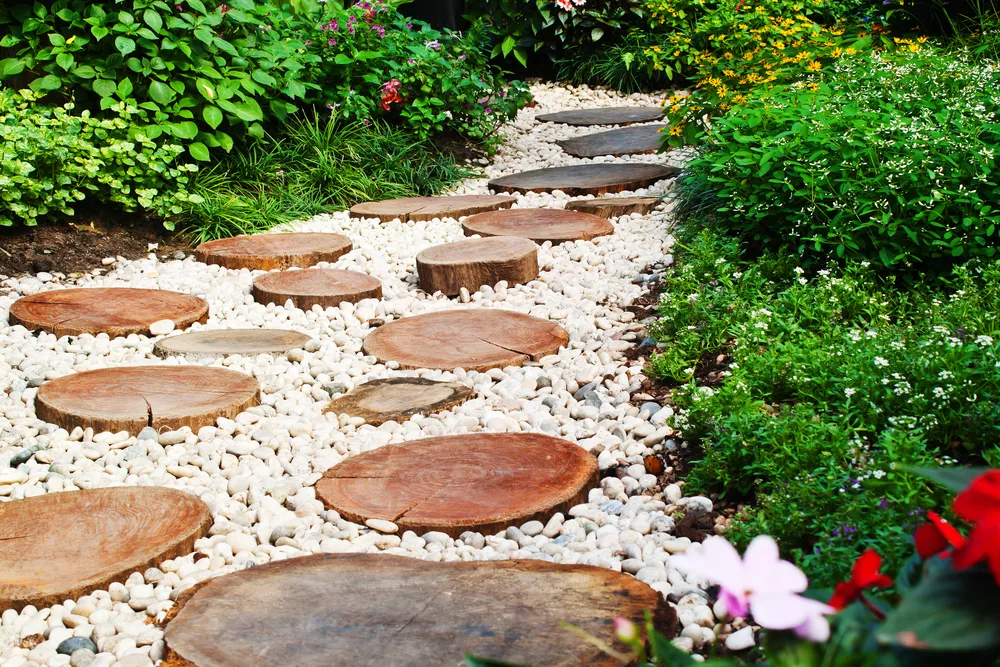
If the ground around your homestead is naturally stoney, you could consider gathering up stones from growing areas to place into trench-style edges around the edges of the growing areas.
You can create a wide range of different effects by choosing different types, shapes and colors of stone to create your in-ground edging strips.
Edging Garden With River Stones @ youtube.com
21. Slate Garden Bed Edging
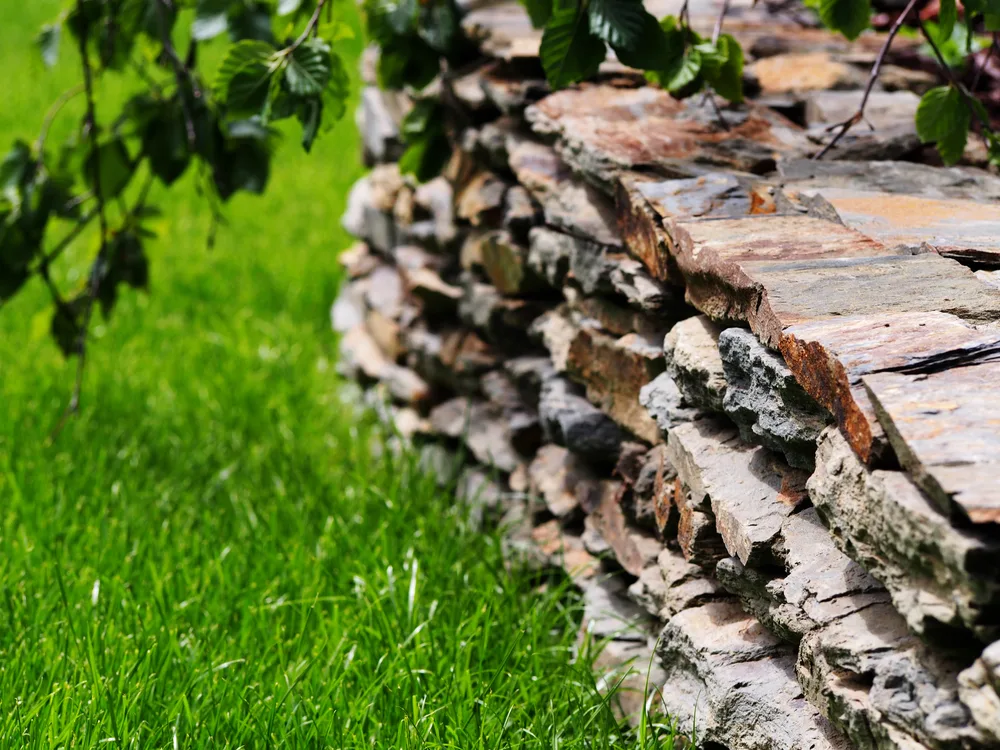
If there is slate in your area, this could also be an eco-friendly edging option.
Larger pieces of slate could be placed upright in the ground to create a garden border.
Small chips of slate could also be placed decoratively in the ground to create a trench style edging that resembles a flowing river.
This and other trench style edging could also serve a practical function and improve drainage.
Creative Garden Edging Ideas @ DIYgarden.co.uk
22. Clay/Cob/Abobe Garden Bed Edging
To partition off a growing area, or form the edge of a raised garden bed, clay-based materials like cob or adobe could be ideal.
You might even be able to make these natural, eco-friendly building materials using clay, straw etc. from your own property.
Cob or adobe structures can be organic in form, or more straight-line and formal. So you can alter the design to fit in with a wide range of different garden styles.
Cob Raised Bed Edging @ pinterest.com
23. Straw Bale Bed Edging
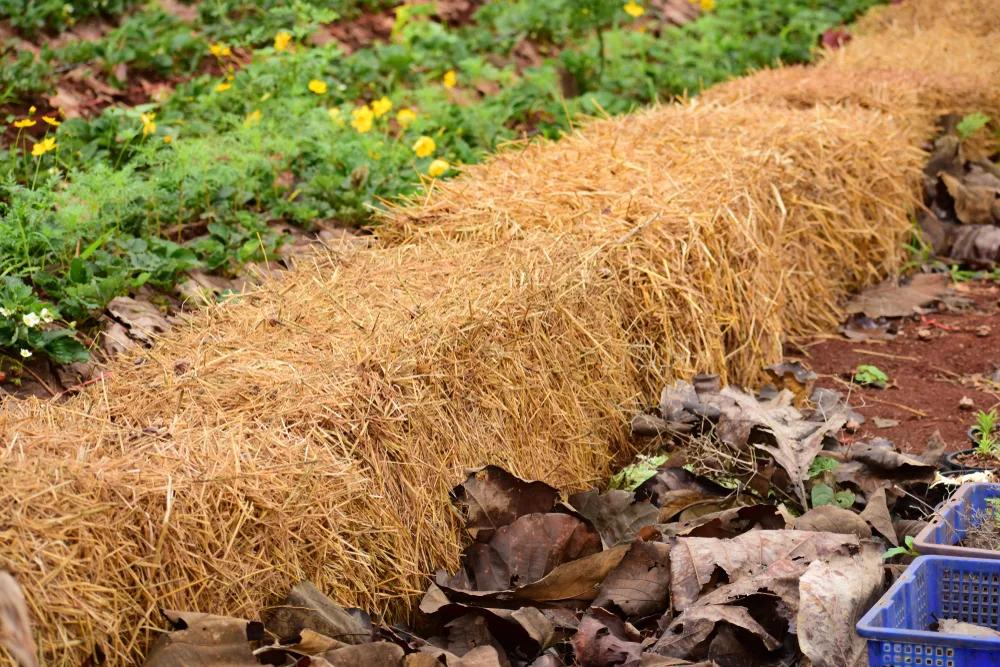
If you can easily source straw bales in your area, these can also be a very useful natural material to consider.
You could think about using straw bales to form the edges of a raised bed. They are wide edging, but can also double as garden seating.
These will not be permanent, but could be a good temporary option in an eco-friendly garden.
Once they have broken down, the straw can then be used as mulch in growing areas, or added to your compost.
Raised Bed From Bales of Straw @ bonnieplants.com
24. Flowing Water Garden Bed Edging
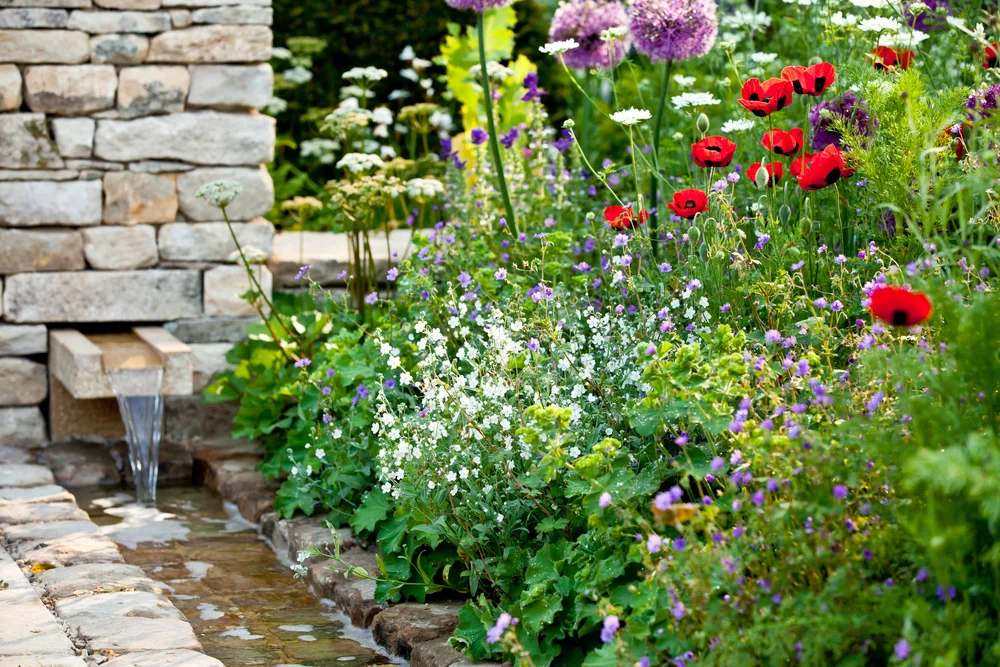
One final natural option to consider for garden edging is creating a flowing stream or irrigation canal to line the edges of your garden beds.
There are a huge range of ways to incorporate water in a garden design. You might wish to create a water feature with constantly flowing water, if water is abundant in your area.
You could also consider feeding a rainwater harvesting system into such a stream or channel, so water flows periodically when it rains.
The water might be contained within the channel using a variety of methods. But it might also be allowed to seep out slowly to irrigate the growing area beyond.
Upcycled Garden Bed Edging Ideas
If none of the natural garden bed edging ideas mentioned above quite fit your needs and wishes, before buying new edging consider upcycling old materials.
Upcycling old materials to make your edging is one great way to reduce waste and cut your carbon footprint.
Here are just some interesting upcycled garden bed edging ideas you could consider:
25. Reclaimed Wood Picket Edging
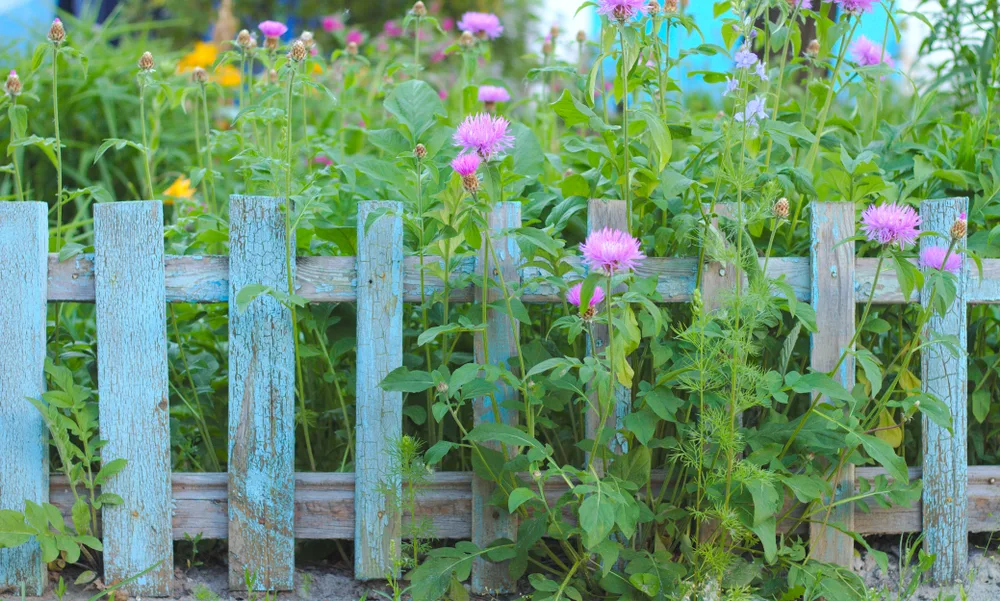
Many homesteaders dream of creating that perfect patch of land with a white picket fence.
The reality of homesteading, as you may already know, does not always live up to the dream. But you can keep your dream alive by creating your own picket fence edging for beds and borders.
By making your own from reclaimed wood, you can reduce the cost, be more sustainable, and get exactly what you want.
You can design a fence to meet your needs – making it exactly the height that you desire.
A low, step-over picket fence could be a great way to edge your annual garden, and could also help protect it.
26. Pallet Wood Garden Bed Edging
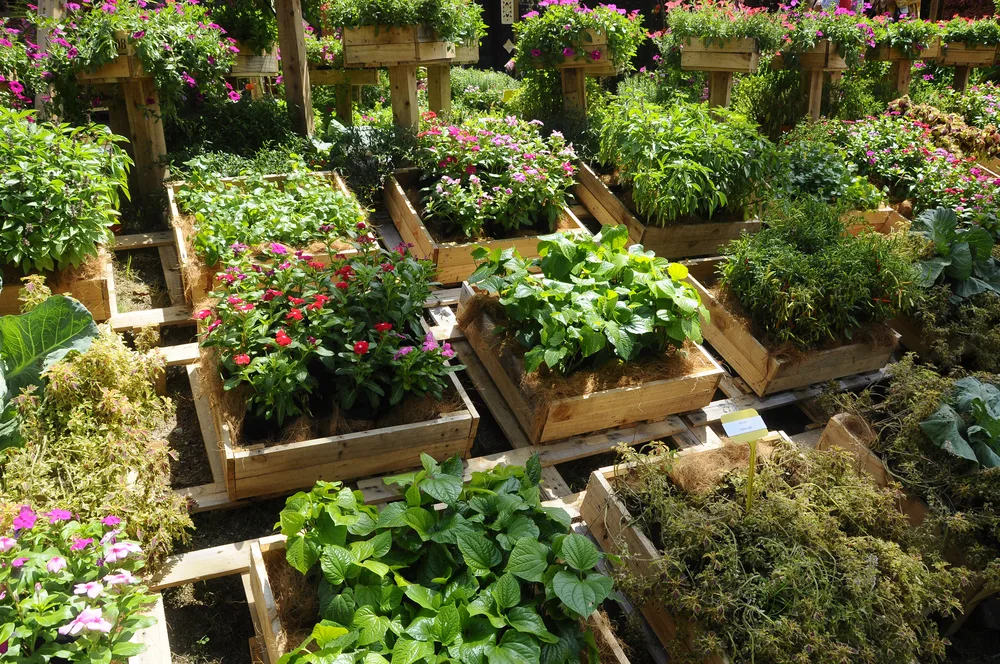
The wood from old pallets (or other reclaimed wood) can also be put to good use to create a wide range of different edging types.
(Just make sure you know where pallets came from, as some may contain harmful toxins.)
You can use reclaimed wood to form a simple edging for in-ground gardens or, by building planks higher, for raised beds. You can then keep it rustic and simple, or paint the reclaimed wood with eco-friendly paint to make it fit in with your overall garden style.
How To Make a Simple Pallet Wood Fence @ youtube.com
27. Reclaimed Sleeper Edging
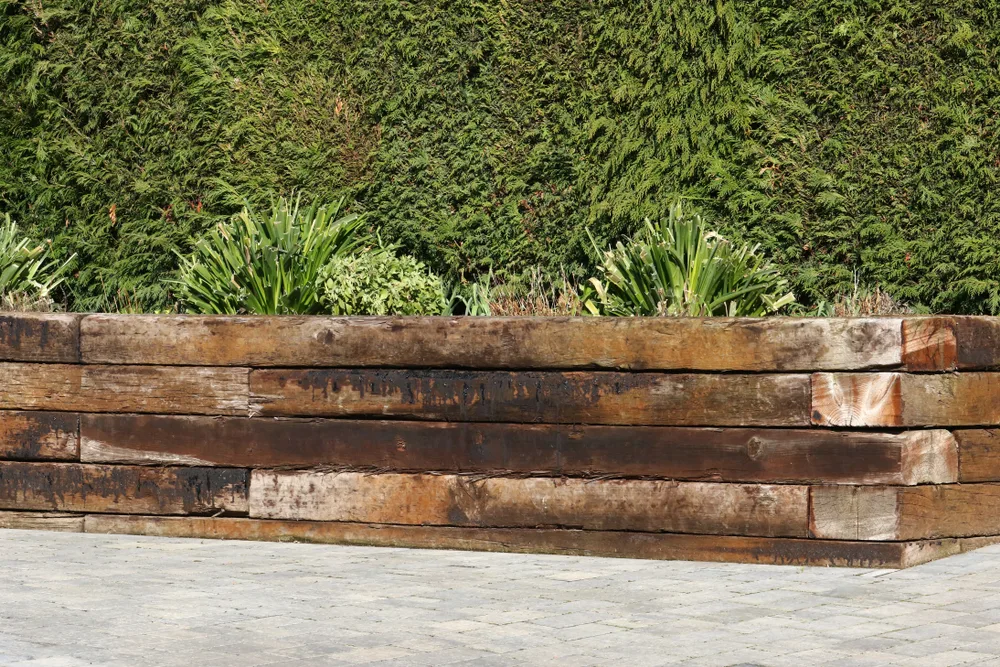
Reclaimed railway sleepers can also make wonderful garden edging. They can simply be laid along the edges of the growing area, or stacked to form chunky wooden edges for raised garden beds.
Just be aware that sleepers can potentially harbor a range of toxins – to be fully aware and informed before you choose to incorporate them into your garden.
How to Lay Sleepers for Garden Edging @ gardendad.co.uk
28. Reclaimed Brick Bed Edging
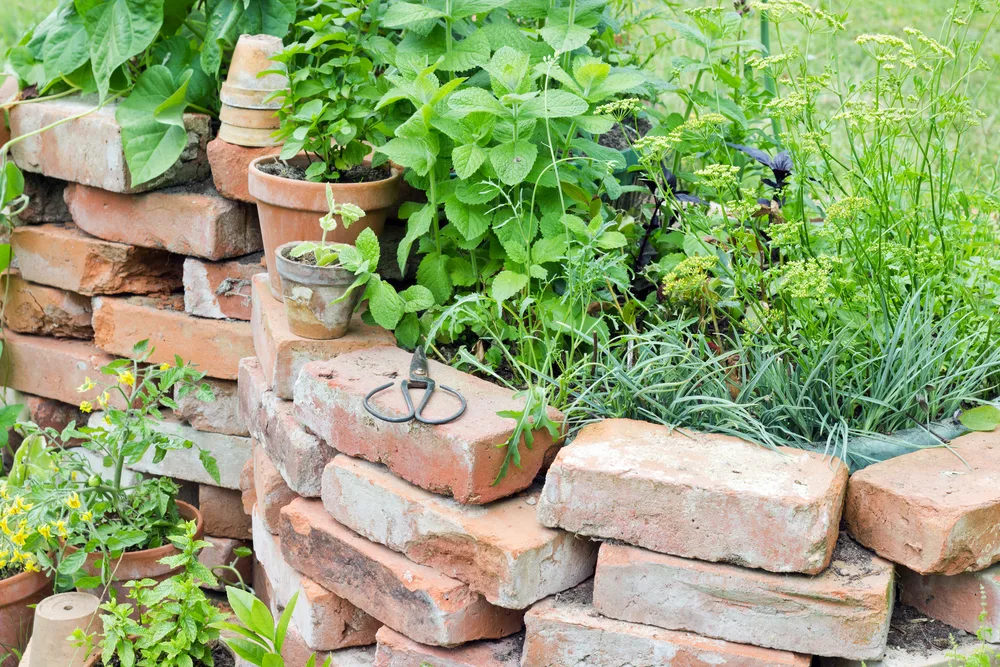
You can create a range of beautiful garden edging types using reclaimed brick.
Reclaimed bricks are a far better choice than new ones, and you will be doing your part by keeping these construction materials from ending up in landfill.
Brick edging is durable, long-lasting, and can look great in a range of different gardens.
It could be a great alternative to stone or rock edging.
Bricks can be built into low edging walls, placed on an angle sticking out of the soil for an interesting effect, or inlaid into the ground around the edges of your growing areas.
How to Edge a Lawn with Bricks @ gardenersworld.com
29. Reclaimed Flagstone Border
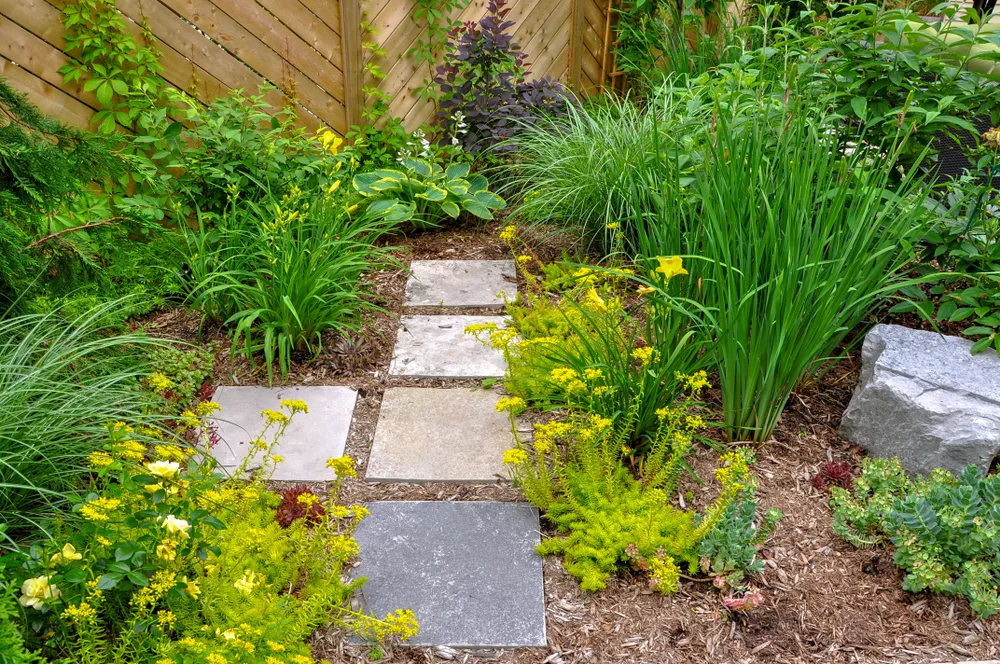
Flagstones can look beautiful in a garden. Rather than buying new, consider using broken reclaimed flagstones to create edging between, for example, a growing area and a lawn.
Flagstones (broken ones especially) could look good placed upright to form edging for ground level garden beds.
They can also be laid flat around the edges for edging that doubles as a path.
How to Make a Stone Path @ familyhandiman.com
30. Reclaimed Concrete Bed Edging
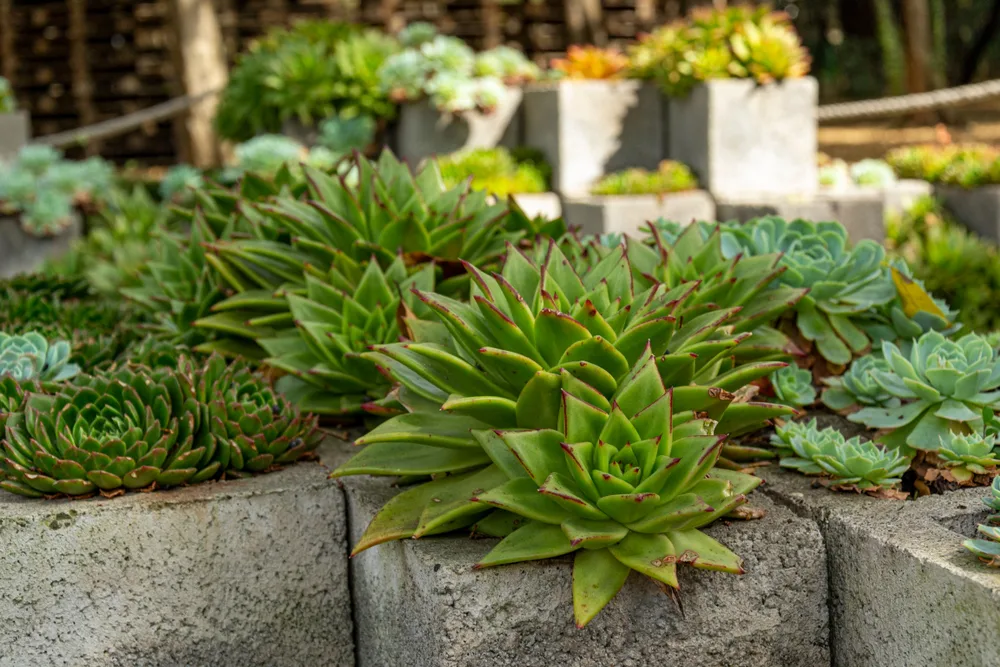
Many modern gardens feature various sorts of concrete edging. But creating concrete comes at a huge cost to the environment.
Rather than pouring new concrete, or buying new concrete blocks, consider using reclaimed concrete blocks or breeze-blocks to create sharp and modern edging in your garden.
Keep concrete raw for an industrial look, or render it with lime render for an eco-friendly contemporary design.
You can also consider planting up the spaces in breeze blocks with companion plants to make the most of your space.
Concrete Raised Beds @ getbusygardening.com
31. Core-Ten Steel Bed Edging
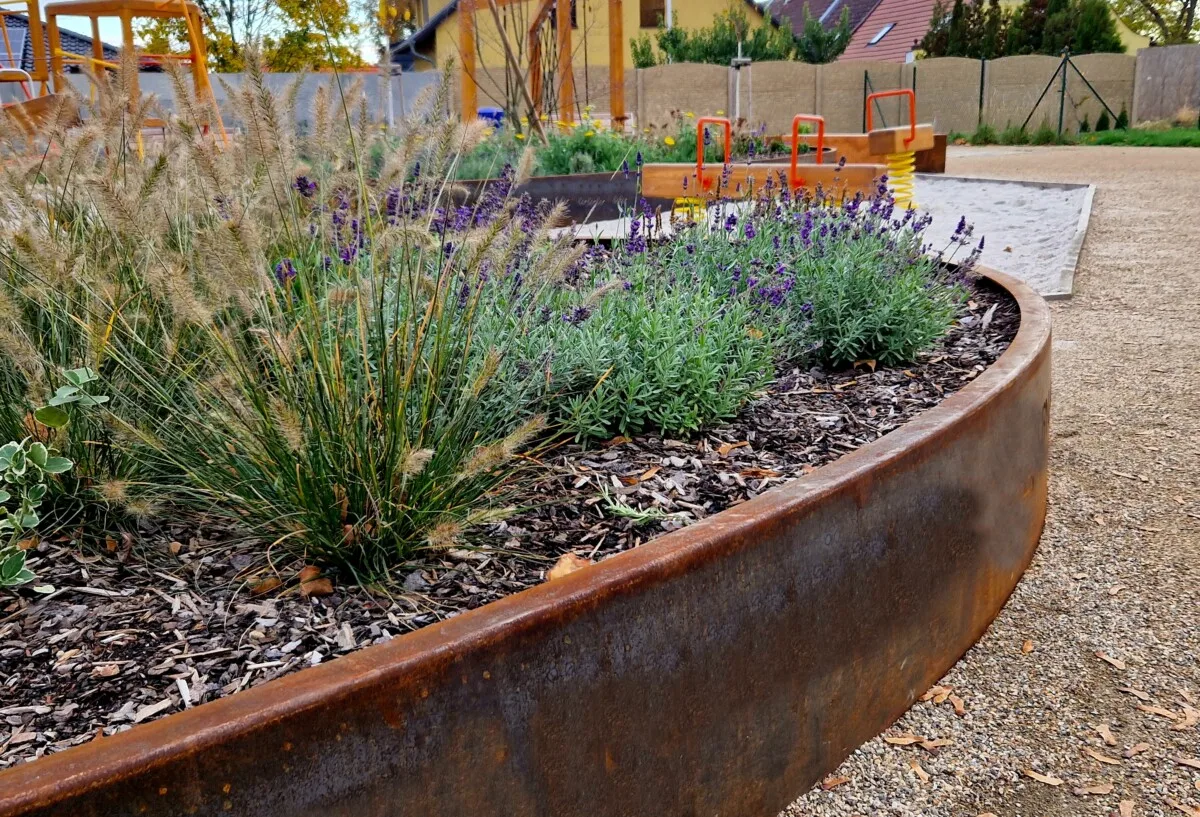
Cor-ten steel can be used to great effect to create low or raised bed edging in a range of settings.
For example, you could use it between a lawn and growing areas.
It can be used to create straight lines, or something more flowing and sinuous. It can look great next to soft grasses and other delicate planting.
This could be a good option for an industrial style garden, and can look either rustic or more sleek and contemporary, depending on exactly how and where it is deployed.
Consider upcycling old metal rather than buying new.
32. Corrugated Metal Edging
Upcycling some old corrugated metal roofing could also make for some great edging for a raised bed or growing area.
Again, using old metal can add an industrial touch to your garden and can look good when softened with a lush and loose planting style.
33. Wheel Rim Garden Bed Edging

Some clever gardeners have also managed to recycle other pieces of scrap metal in their gardens.
For example, bicycle wheel rims can be ‘planted’ along the edge of a garden bed to create a quirky and interesting boundary and separate the planting area from other garden zones.
Check out one cool example of wheel rim garden edging at the link below.
Salvage Garden Art @ thisoldhouse.com
34. Fencing Wire Gabion Edging
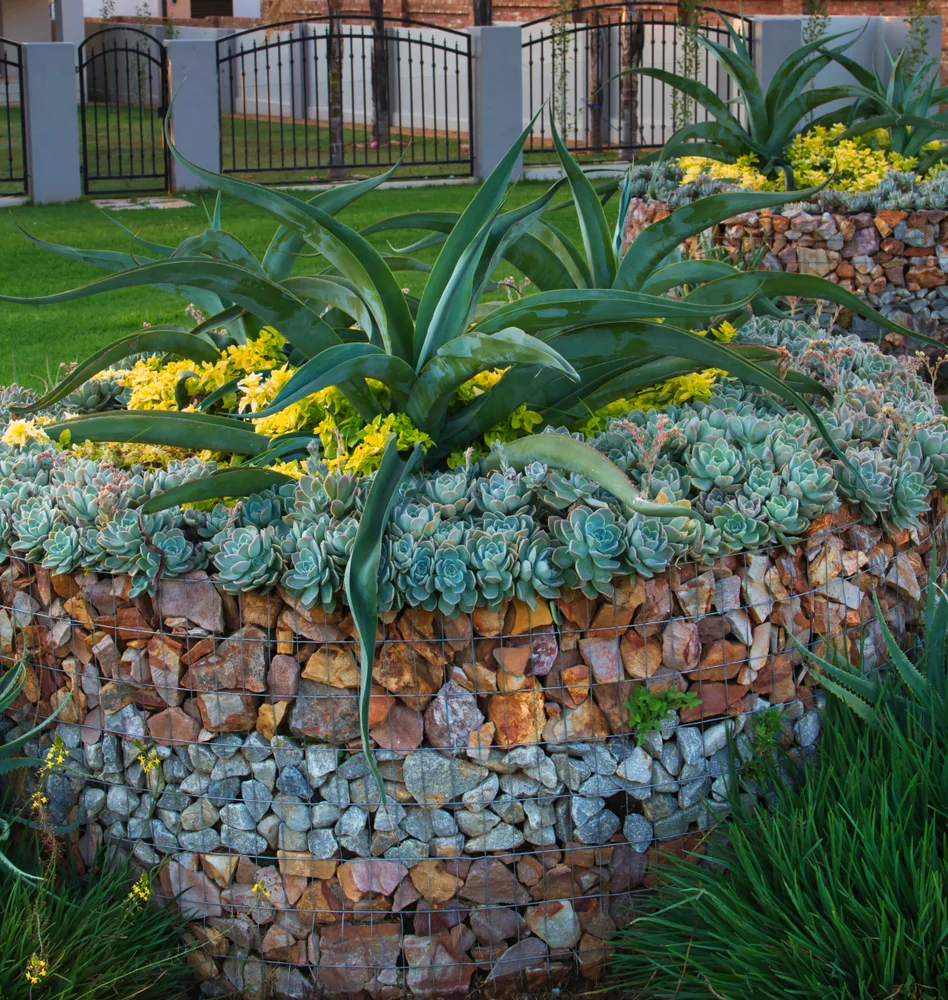
If you can source old wire mesh, fencing wire or chicken wire, you could consider making gabion metal mesh boxes to place along the side of a raised bed or other garden zone.
The gabions can be filled with rocks and stones, old tiles and pipework, or even layered up with natural materials to turn them into an interesting wildlife habitat.
You may even be able to top your gabions with wood to turn them into edge benching, allowing you to sit and enjoy your garden.
DIY gabion baskets @ instructables.com
35. Metal Pipe Garden Bed Edging
A trip to a junk yard or scrap metal merchant might yield wide metal pipe that could be placed upright along the edge of a garden bed.
These pipes could then be planted up with companion plants to attract beneficial wildlife to this part of your garden.
36. Ceramic Pipe Edging
You might also be able to find ceramic pipe. Sections of ceramic pipe (or old chimney pots) could also be placed upright to create garden bed edging.
You can plant these up in exactly the same way as described for the metal pipe edging listed above.
Marcus and Jenny’s Vegetable Garden @ apartmenttherapy.com
37. Ceramic Tile Bed Edging
Ceramic tiles can also be upcycled to create beautiful bed edging. You could even use offcuts or broken tiles for the purpose.
Tiles could be placed upright in the soil along the edge of a ground level garden bed, or inset into the ground – along the edge of a lawn, for example.
38. Plant Pot Bed Edging
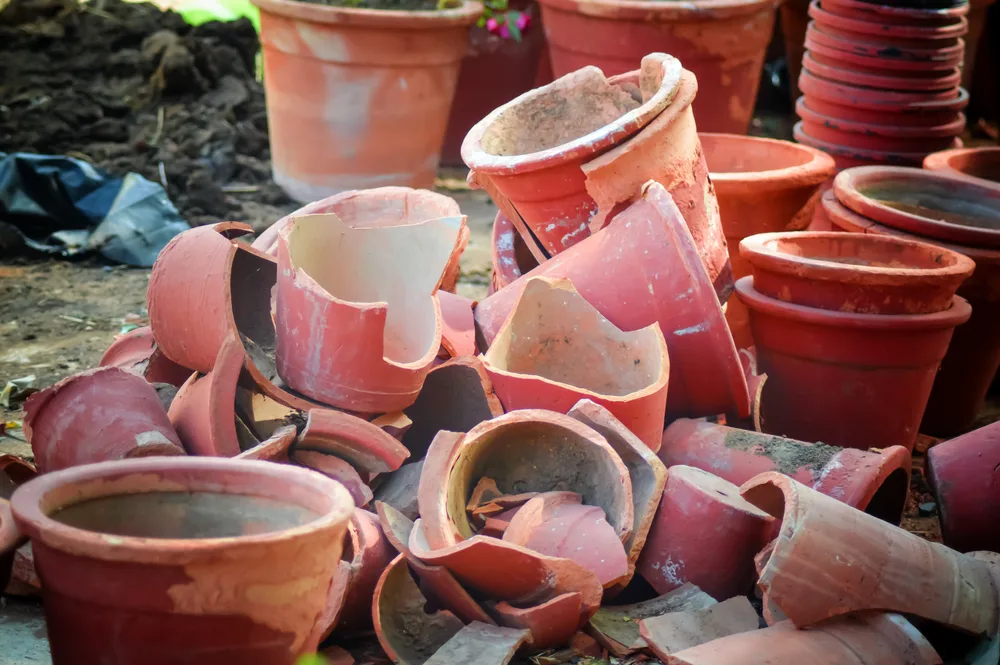
Old terracotta plant pots that are broken or no longer in use could also be used to create an interesting garden bed edging.
Simply lay the pots on their sides, stacked close together.
This can be an effective way to create a low barrier between two distinct zones in your garden.
Pot Plant Edging @ pinterest.co.uk
39. Tire Bed Edging
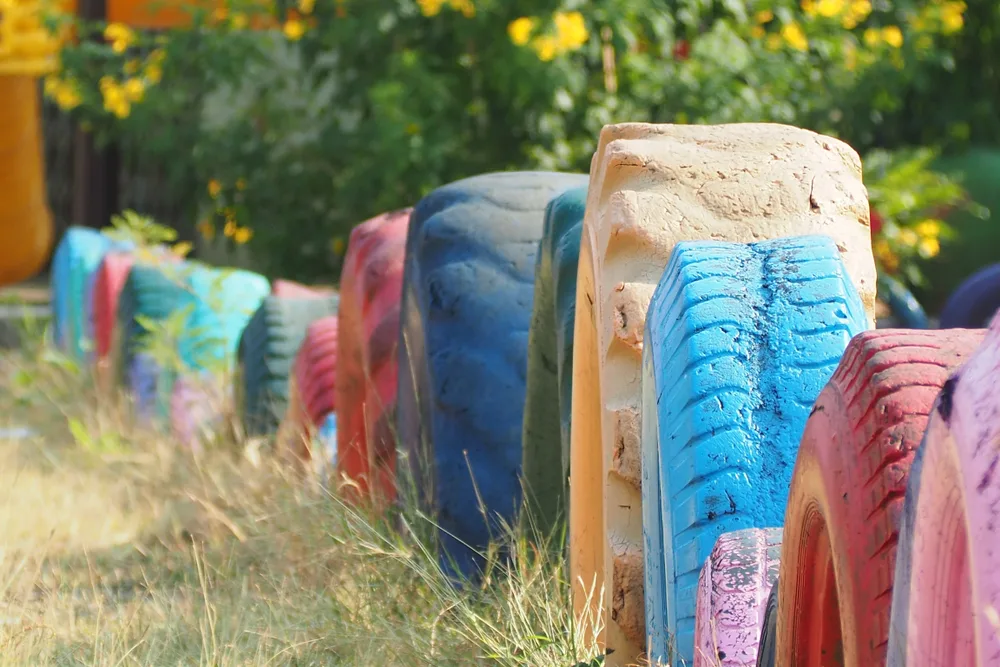
There are many ways to upcycle old tires. One great idea is to cut them in half and use them to mark the boundary of a garden bed or border.
You could also consider making a row of small tires on the edge of a bed, and planting up each one with some beautiful flowers.
You could leave them as they are, or paint or clad them to create a different effect.
40. Garden Hose Fence Edging
Another item that it would be great to keep from landfill is your old garden hose. If your hose it leaking, don’t throw it away.
Consider hammering in some stakes and weaving your hose through it to create a small fence as garden bed edging.
See an example here @ karapaslaydesigns.com
41. Upcycled Plate Garden Bed Edging
Another quirky idea is to take a look in your kitchen, in local thrift stores or charity shops to find old plates to upcycle.
Consider using broken or chipped plates to create some attractive edging for a bed or border.
Simple bury these partially in the soil, stood upright so you can still enjoy their designs.
Upcycled plate edging @ diygarden.co.uk
42. Glass Bottle Edging
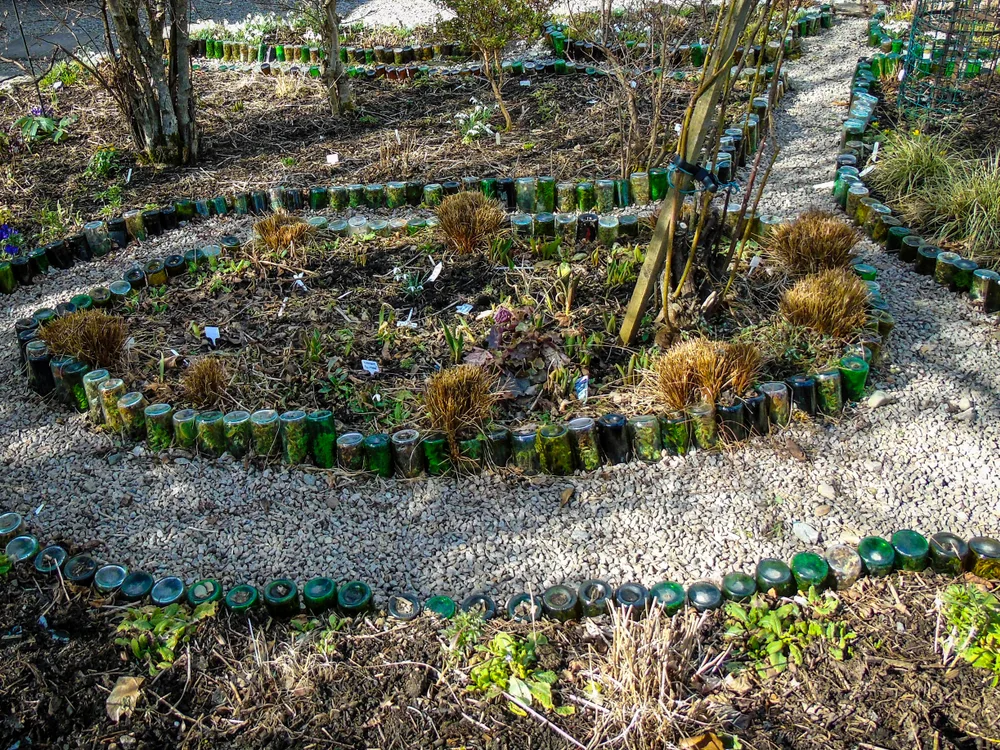
If you like a tipple, you don’t necessarily need to send all those glass bottles off for recycling.
You could also consider saving them up and using them to line the edges of a garden bed or pathway.
Place the bottles upside down with the necks buried in the soil (and lids on to prevent slugs etc. from coming up inside.)
You could create an interesting edging with bottles of different colours, shapes and sizes.
43. Plastic Bottle Edging
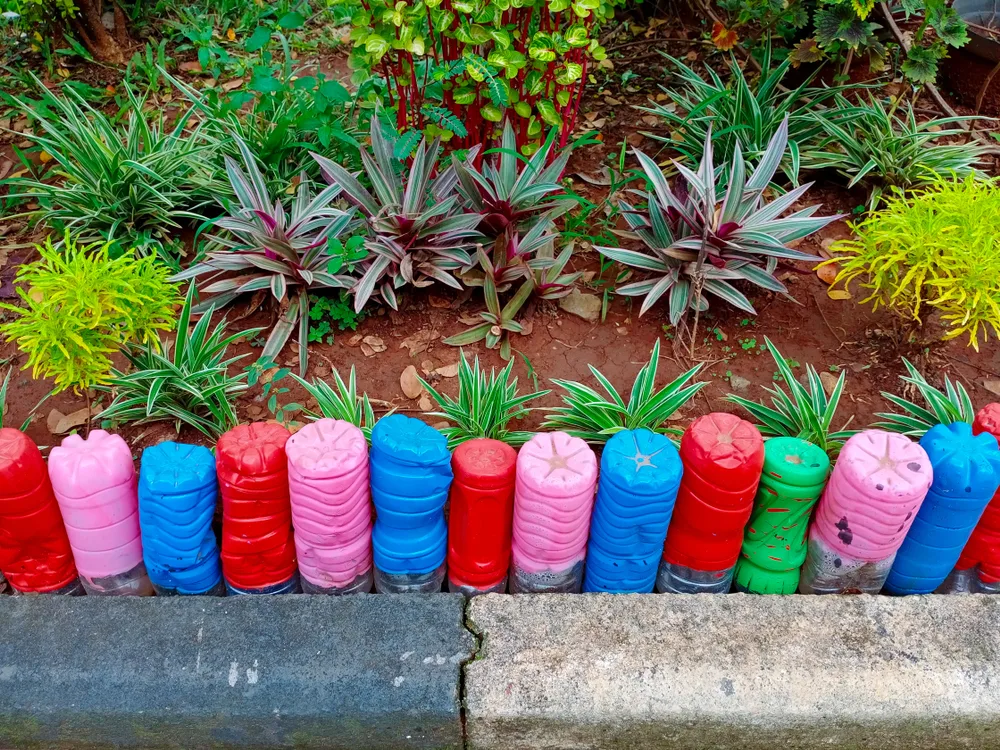
You could also place plastic bottles buried around the edges of your annual vegetable growing area.
Fill these with water and they could also serve a useful function and slowly release water to be taken up from your plants while you are away from home.
So this edging idea could be functional as well as decorative.
44. Tin Can Bed Edging
A series of tin cans could also be recycled as garden bed edging. You could simply allow these to naturally rust, or paint them with eco-friendly paint to create a more long-lasting and brightly coloured edging for your garden.
45. Mosaic Bed Edging
One final, delightful idea to consider is creating a mosaic strip to separate different garden zones, or to edge a pathway through your garden.
You could use natural materials like different coloured stones and pebbles to make your mosaic. But you could also choose to upcycle a range of different materials for the purpose.
For example, you could make your mosaic with broken tiles, coloured glass or even pieces of colourful plastic packaging, bottle caps or plastic lids.
Creating a mosaic strip from unusual reclaimed materials could be a great way to add personality and individuality to your garden.
Check out some inspiring garden mosaic ideas @ amazinginteriordesign.com.
I hope that by now, you have been inspired by this list of creative garden bed edging ideas and have a good idea of which way you would like to go in your garden.
Just remember – all that really limits your options is your imagination.

Get the famous Rural Sprout newsletter delivered to your inbox.
Including Sunday musings from our editor, Tracey, as well as “What’s Up Wednesday” our roundup of what’s in season and new article updates and alerts.


